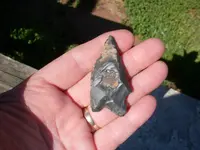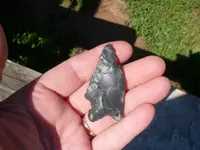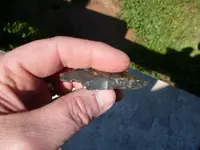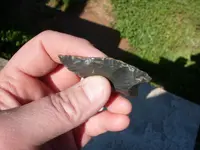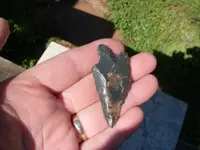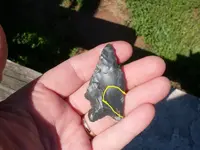You are using an out of date browser. It may not display this or other websites correctly.
You should upgrade or use an alternative browser.
You should upgrade or use an alternative browser.
✅ SOLVED Nothing is sexier that a point!
- Thread starter rock
- Start date
rockheadhunter421
Sr. Member
- Joined
- Mar 25, 2014
- Messages
- 349
- Reaction score
- 193
- Golden Thread
- 0
- Primary Interest:
- All Treasure Hunting
Lmao! The bikini top fell off on that one!

rockheadhunter421
Sr. Member
- Joined
- Mar 25, 2014
- Messages
- 349
- Reaction score
- 193
- Golden Thread
- 0
- Primary Interest:
- All Treasure Hunting
The Dalton was in this area plenty. I have found many brifacated bases but never one that was a whole piece. It is in a frame rite now by the way. Its probably one of the oldest points I have found whole. Thanks for everyones help, rock
I enjoyed trying help. I think it was a great find really! It reminds me of what I like to call that "Gucci" material here. If I find that, you better believe it will put a smile on my face. Then, if I find some more quartz crystal, I like to call that material "Victoria's Secret." Oh, I can just imagine it now.

rock
Gold Member
- #43
Thread Owner
They say Buzzard Roost falls under Benton's. Overstreet is a good guide to start with. Many people get in a tissy because a few points are mis named and they acknowledge a snapped base Kirk. Funny how that drives people crazy. Then it;s a price guide too.Hothem and others never came close to what Bob Overstreet did in trying to ID and publishing. If you want specific stick to your local dig reports. Hothem shows a similar one as a St. Albans but mostly only gives examples from Va and N.C for the South East and no other clues.Nothing n Ga
The pottery around here is even named after bridges and roads and Islands. Here our time frames are called the Dallas Period in late Mississipian times.Local yocal knowledge. These things makes no sense if you are a googler.
A local show will be a good bet Rock. Even then from table to table you might get different views,lol.
I think Hippy is pretty good at point I.D and can usually say why. I can not do that. It is easy to click in and type "geofact" It is harder to try and nail something down and very easy to be wrong…
Somebody send a pm to some of the more experienced guys. I really would like to get a solid ID on it. Every time I find 1 in that creek it is a different type. The creek has flooded over the banks 3 times already this yr so some have washed out. I just need the water to keep dropping. Thanks
yakker
Bronze Member
Reading all this... I understand the desire to give an artifact a 'name', and I also understand that from region to region, names change. And that there are slight variations to 'standard' types- which change the name from one to another. I get that. But isn't it possible- just possible that the piece doesn't really have a name? Isn't it possible that it's a piece w/ origins in the bifurcated realm, but it didn't behave as the knapper wanted, so it ended up being a knife w/ hard to distinguish origins because of it's difficult manufacture? Isn't it possible that a decent-looking chunk of rock proves to be a gnarly mess, and having gone as far as the knapper already had, he/she decided to use the remains as best as they could? I mean, I get that people want to know- for sure (or as sure as they can be) the age or technical relevance of the style of knapping- to best gage the age, but how far does one go? How far do you bend over backward to give a piece a name? Or is the real intent to understand the precedent for the see-able-- the flaking technique, the material, the base. It seems to me, sometimes the best you can really do, in all honesty, is say that it's paleo, archaic, woodland, etc.(and the sub-categories within those eras). Given that it's not a 'fine' specimen, with tell-tale base or flaking, isn't it okay to just say it's a tool from the '____' era?
It seems that so often we (all) get caught up in naming something- as though the name alone will give it credence. Justify it's existence in a collection. Is it not equally important to take a piece, keep it in a location box, and see what else might be found in the same place- for comparison- to build a decent argument for such-and-such an age/era/technology? I do understand the problem w/ erosion finds. That's all I find. So artifacts are out of context from well before I find them. But, that said, I do find similar items over time, and can draw conclusions from the group- rather than the singular item.
Maybe I'm way out in left field here. And again, I'm not trying to be abrasive or a wet blanket, but I get a bit frustrated with the name-game. And although Overstreet is an excellent starter book- and as comprehensive as an all-purpose guide can be, it does not address specific locations, regions with the detail necessary to draw realistic 'absolutes' about anything beyond the more broadly understood typologies. It was the first book I bought with regards to this 'hobby/obsession', and I use it very rarely- and only when trying to get a broad understanding of artifacts found in locations other than the one I live and hunt in. For my location, there are books written specifically concerning my area/region. Those are gold. When I first started, I kept thinking my finds had similarities to pieces found hundreds of miles away, and thus had the same name. Big oops. Using only Overstreet was problematic. Adding to my research library helped enormously, as I found pieces more similar to mine- and with different names. But names are only part of the equation. If a person from a different area sees a piece named ___, and they have a piece like it, they might assume it has the same name. Especially if they don't have years and years of research study in various regions. These region-specific books are not necessarily on line. More are small publications- often for use in universities and colleges.
In my business, we speak of 'food ways'-- the routes various foods traveled to various parts of the globe over time. Maybe the study of how technology flowed from one region to another over what period of time would be more helpful than trying to give a specific, imperfect tool a name.
All that said, I too would have picked it up and been happy with it. Congrats on your find- especially considering the short hunt! Yakker
It seems that so often we (all) get caught up in naming something- as though the name alone will give it credence. Justify it's existence in a collection. Is it not equally important to take a piece, keep it in a location box, and see what else might be found in the same place- for comparison- to build a decent argument for such-and-such an age/era/technology? I do understand the problem w/ erosion finds. That's all I find. So artifacts are out of context from well before I find them. But, that said, I do find similar items over time, and can draw conclusions from the group- rather than the singular item.
Maybe I'm way out in left field here. And again, I'm not trying to be abrasive or a wet blanket, but I get a bit frustrated with the name-game. And although Overstreet is an excellent starter book- and as comprehensive as an all-purpose guide can be, it does not address specific locations, regions with the detail necessary to draw realistic 'absolutes' about anything beyond the more broadly understood typologies. It was the first book I bought with regards to this 'hobby/obsession', and I use it very rarely- and only when trying to get a broad understanding of artifacts found in locations other than the one I live and hunt in. For my location, there are books written specifically concerning my area/region. Those are gold. When I first started, I kept thinking my finds had similarities to pieces found hundreds of miles away, and thus had the same name. Big oops. Using only Overstreet was problematic. Adding to my research library helped enormously, as I found pieces more similar to mine- and with different names. But names are only part of the equation. If a person from a different area sees a piece named ___, and they have a piece like it, they might assume it has the same name. Especially if they don't have years and years of research study in various regions. These region-specific books are not necessarily on line. More are small publications- often for use in universities and colleges.
In my business, we speak of 'food ways'-- the routes various foods traveled to various parts of the globe over time. Maybe the study of how technology flowed from one region to another over what period of time would be more helpful than trying to give a specific, imperfect tool a name.
All that said, I too would have picked it up and been happy with it. Congrats on your find- especially considering the short hunt! Yakker
intensecrasher
Sr. Member
- Joined
- Apr 6, 2014
- Messages
- 258
- Reaction score
- 247
- Golden Thread
- 0
- Location
- California
- Detector(s) used
- Ground-penetrating radar...LOL
- Primary Interest:
- Relic Hunting
Lets see if we can identify what ""type" she is?
By the way, I totally agree with you that points are sexy...as long as no one tells my wife I said it!!!
By the way, I totally agree with you that points are sexy...as long as no one tells my wife I said it!!!
rock
Gold Member
- #46
Thread Owner
To me which it is hard to tell completely with the inclusion but I would say Archaic now I dont know which but if I was guessing that would be my answer. I have never found anything in the creek I would consider Paleo. It very well could of broke and then was reworked on the edge that is beveled. I believe it might of been as wide as the other side is now. Ive never found one like it before but hopefully when I can get back there will be another waiting on me to pick it up. Then I will have something to compare it with. HH, rock
old digger
Gold Member
rockheadhunter421
Sr. Member
- Joined
- Mar 25, 2014
- Messages
- 349
- Reaction score
- 193
- Golden Thread
- 0
- Primary Interest:
- All Treasure Hunting
Lol, I found a 4" long, Snapped Base Kirk once. You know what many collectors I showed it to said about the flaking? They said, "looks like Paleo flaking to me." Heck, when I found it I really didn't have a clue what it was. I thought it was a preform. So when I saw a broken base and a long, worked blade, I thought it was unfinished or it was a pre-form of some arrowhead type. That thought has always stuck with me. I have no resource to prove it but I believe a Snapped Base Kirk can be a preform (esp. a large example). All the knapper had to do is notch the sides and grind the base for hafting. Seems simple to me for a survival situation but I'm not sure if it's true?Many people get in a tissy because a few points are mis named and they acknowledge a snapped base Kirk. Funny how that drives people crazy.

GatorBoy
Gold Member
- Joined
- May 28, 2012
- Messages
- 14,716
- Reaction score
- 6,156
- Golden Thread
- 0
- Primary Interest:
- All Treasure Hunting
..( broken base)..Has anyone ever been able to explain one good reason why anyone would go through the trouble of forming a base on a point just to snap it off?
I know we've gone over this a thousand times but it seems like an awful big coincidence that the person who coined the term "snap base".. (Overstreet)....Found alot of them ... Talked to the right people... and got the name.. . .. Just happened to benefit monetarily by considering broken Kirks a complete piece when adding them to his price guide and selling them.
Sure everyone has their opinions.. But I've never heard a credible one for why someone would knap a base onto a point then break it off... Its just broken as far as I'm concerned
I know we've gone over this a thousand times but it seems like an awful big coincidence that the person who coined the term "snap base".. (Overstreet)....Found alot of them ... Talked to the right people... and got the name.. . .. Just happened to benefit monetarily by considering broken Kirks a complete piece when adding them to his price guide and selling them.
Sure everyone has their opinions.. But I've never heard a credible one for why someone would knap a base onto a point then break it off... Its just broken as far as I'm concerned
Last edited:
rockheadhunter421
Sr. Member
- Joined
- Mar 25, 2014
- Messages
- 349
- Reaction score
- 193
- Golden Thread
- 0
- Primary Interest:
- All Treasure Hunting
..( broken base)..Has anyone ever been able to explain one good reason why anyone would go through the trouble of forming a base on a point just to snap it off?
I know we've gone over this a thousand times but it seems like an awful big coincidence that the person who coined the term "snap base".. (Overstreet)....Found alot of them ... Talked to the right people... and got the name.. . .. Just happened to benefit monetarily by considering broken Kirks a complete piece when adding them to his price guide and selling them.
Sure everyone has their opinions.. But I've never heard a credible one for why someone would knap a base onto a point then break it off... Its just broken as far as I'm concerned
I understand what you mean, but I guess what I was trying to explain went over your head. Or you failed to read it all and answer my question. Even if the base was snapped intentionally, I don't think they just knapped it and then broke it off after they done it. I was wondering if they snapped it with intentions of creating a new form or it might have served as a preform. Yeah it's just broken, but if a numerous amount of Kirks with snapped bases were recovered (all having that similar characteristic) then that seems more than just an accident. It's not like them Kirk people had a tradition of snapping their bases after they knapped them. Did they all stand in a circle around their camp fires and say alright on three, so they could all hear the snapping sound that it made? Lol. I am speculating also that maybe the larger forms could make a larger point/tool and the smaller forms could make a smaller point/tool. There seems to be a size and function to some their the tools that were utilized also. My question is: does that seem simple and quick, and for a survival situation, that an ancient person was smart enough to utilize that Kirk Snap Base into a form so that it could serve as a multi tool or another arrowhead type?
Last edited:
GatorBoy
Gold Member
- Joined
- May 28, 2012
- Messages
- 14,716
- Reaction score
- 6,156
- Golden Thread
- 0
- Primary Interest:
- All Treasure Hunting
Let me tell you something nothing went over my head and I've read enough from you to know you're in no position to speak that way to me.... I do not have the obligation of reading every single word you wright because you write a hell of a lot of them but yes I did read the entire thing.... not really appreciating your pretentiousness.
Believe it or not somehow us slumps managed to get along before you so graciously came here to teach everyone... You should set down you're Overstreet book and spend some time learning from a lot of the folks here.. There's a large knowledge base in the group of people here many of them with more experience than you.
I simply gave my opinion not speaking directly to you... because believe it or not there are other people here... Though a large majority of them are not bothering to spend a bunch of time typing in what is apparently The Rock head show. I think I'll stick with my original name for you ... And just call you Yikes.
Believe it or not somehow us slumps managed to get along before you so graciously came here to teach everyone... You should set down you're Overstreet book and spend some time learning from a lot of the folks here.. There's a large knowledge base in the group of people here many of them with more experience than you.
I simply gave my opinion not speaking directly to you... because believe it or not there are other people here... Though a large majority of them are not bothering to spend a bunch of time typing in what is apparently The Rock head show. I think I'll stick with my original name for you ... And just call you Yikes.
Last edited:
GatorBoy
Gold Member
- Joined
- May 28, 2012
- Messages
- 14,716
- Reaction score
- 6,156
- Golden Thread
- 0
- Primary Interest:
- All Treasure Hunting
I enjoyed trying help. I think it was a great find really! It reminds me of what I like to call that "Gucci" material here. If I find that, you better believe it will put a smile on my face. Then, if I find some more quartz crystal, I like to call that material "Victoria's Secret." Oh, I can just imagine it now.
Real experience there..hmmm..
Last edited:
painterx7
Silver Member
- Joined
- Jul 20, 2013
- Messages
- 2,886
- Reaction score
- 2,579
- Golden Thread
- 0
- Primary Interest:
- All Treasure Hunting
Nice read bossReading all this... I understand the desire to give an artifact a 'name', and I also understand that from region to region, names change. And that there are slight variations to 'standard' types- which change the name from one to another. I get that. But isn't it possible- just possible that the piece doesn't really have a name? Isn't it possible that it's a piece w/ origins in the bifurcated realm, but it didn't behave as the knapper wanted, so it ended up being a knife w/ hard to distinguish origins because of it's difficult manufacture? Isn't it possible that a decent-looking chunk of rock proves to be a gnarly mess, and having gone as far as the knapper already had, he/she decided to use the remains as best as they could? I mean, I get that people want to know- for sure (or as sure as they can be) the age or technical relevance of the style of knapping- to best gage the age, but how far does one go? How far do you bend over backward to give a piece a name? Or is the real intent to understand the precedent for the see-able-- the flaking technique, the material, the base. It seems to me, sometimes the best you can really do, in all honesty, is say that it's paleo, archaic, woodland, etc.(and the sub-categories within those eras). Given that it's not a 'fine' specimen, with tell-tale base or flaking, isn't it okay to just say it's a tool from the '____' era? It seems that so often we (all) get caught up in naming something- as though the name alone will give it credence. Justify it's existence in a collection. Is it not equally important to take a piece, keep it in a location box, and see what else might be found in the same place- for comparison- to build a decent argument for such-and-such an age/era/technology? I do understand the problem w/ erosion finds. That's all I find. So artifacts are out of context from well before I find them. But, that said, I do find similar items over time, and can draw conclusions from the group- rather than the singular item. Maybe I'm way out in left field here. And again, I'm not trying to be abrasive or a wet blanket, but I get a bit frustrated with the name-game. And although Overstreet is an excellent starter book- and as comprehensive as an all-purpose guide can be, it does not address specific locations, regions with the detail necessary to draw realistic 'absolutes' about anything beyond the more broadly understood typologies. It was the first book I bought with regards to this 'hobby/obsession', and I use it very rarely- and only when trying to get a broad understanding of artifacts found in locations other than the one I live and hunt in. For my location, there are books written specifically concerning my area/region. Those are gold. When I first started, I kept thinking my finds had similarities to pieces found hundreds of miles away, and thus had the same name. Big oops. Using only Overstreet was problematic. Adding to my research library helped enormously, as I found pieces more similar to mine- and with different names. But names are only part of the equation. If a person from a different area sees a piece named ___, and they have a piece like it, they might assume it has the same name. Especially if they don't have years and years of research study in various regions. These region-specific books are not necessarily on line. More are small publications- often for use in universities and colleges. In my business, we speak of 'food ways'-- the routes various foods traveled to various parts of the globe over time. Maybe the study of how technology flowed from one region to another over what period of time would be more helpful than trying to give a specific, imperfect tool a name. All that said, I too would have picked it up and been happy with it. Congrats on your find- especially considering the short hunt! Yakker

yakker
Bronze Member
I tend to agree w/ Old Digger on this one. And thanks Painterx7 (I really need to self-edit...that's too much). Yak
rockheadhunter421
Sr. Member
- Joined
- Mar 25, 2014
- Messages
- 349
- Reaction score
- 193
- Golden Thread
- 0
- Primary Interest:
- All Treasure Hunting
Real learning experience here sounds like you're into crossdressing or something... Don't talk about going over my head with anything..
Maybe open your mind a little better, Mr. 10,800 posts. You have a lot of posts but come across as lacking in your debating techniques on a forum. Obviously, "Victoria's Secret" went right over your head too b/c this thread is talking sexy points. That's my high quality material either way I want to look at it. Personally, that's like my own inside comment. It seems like your jealous and a grump. I'm not a serious, big-time arrowhead hunter all the time. I like to be humorous to my friends I hunt with. I actually thought Rock's point is sexy so I wanted to give him a few ideas on the type based on my resource. I don't care if I'm right and he calls it something else. He can call it "Sexy Mamasita" for all I care. So just get on outta here with that silly Alligator Shuffle!
Last edited:
yakker
Bronze Member
Stop it. This is not the etiquette forum, the finger-pointing forum, the nya-nya forum,nor the forum to discuss anything you feel like calling sexy. The moderator knows how to 'stop this car right now'...so stop poking each other! Yakker
rockheadhunter421
Sr. Member
- Joined
- Mar 25, 2014
- Messages
- 349
- Reaction score
- 193
- Golden Thread
- 0
- Primary Interest:
- All Treasure Hunting
I keep trying trying to read your long post and I keep getting interrupted. I just can't muster that one yet. LolI tend to agree w/ Old Digger on this one. And thanks Painterx7 (I really need to self-edit...that's too much). Yak
- Joined
- Jan 27, 2009
- Messages
- 18,875
- Reaction score
- 12,136
- Golden Thread
- 1
- Location
- South East Tennessee on Ga, Ala line
- 🥇 Banner finds
- 1
- Detector(s) used
- Tesoro Conquistador freq shift
Fisher F75
Garrett AT-Pro
Garet carrot
Neodymium magnets
5' Probe
- Primary Interest:
- All Treasure Hunting
Lets stop arguing please. First of all the point was chunked probably because it was turning out badly. It never made it to a point type and is doubtful it can ever be solved. As far as snapped base Kirks if anyone ever found them and saw the snap is actually worked you might change your mind . But this thread is not about that piece and should be marked as solved as the original OP is not accepting any answer and wants an ID that may not be possible. It is becoming a pissing match.
Rock your thread your call.
Rock your thread your call.
Last edited:
Similar threads
- Replies
- 9
- Views
- 839
- Replies
- 16
- Views
- 897
Users who are viewing this thread
Total: 1 (members: 0, guests: 1)

